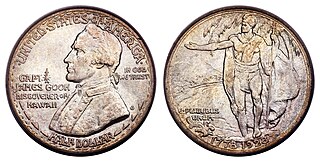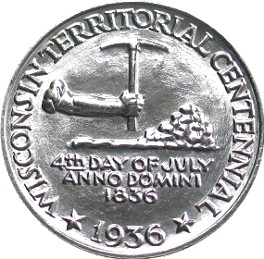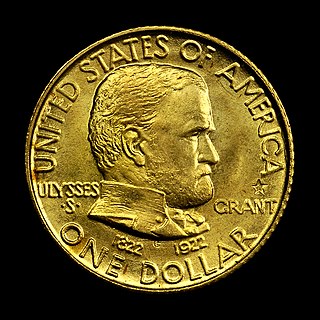
The Alabama Centennial half dollar, or Alabama half dollar, was a commemorative fifty-cent coin struck by the United States Bureau of the Mint in 1921 as a belated acknowledgement of the 100th anniversary of Alabama's admission to the Union in 1819. The coin was created by Laura Gardin Fraser, the first woman credited with designing a coin.

The Bridgeport, Connecticut, Centennial half dollar is a commemorative fifty-cent piece issued in 1936 by the United States Bureau of the Mint to honor the 100th anniversary of the incorporation of Bridgeport, Connecticut, as a city. Designed by Henry Kreis, the obverse depicts the showman P. T. Barnum, who was one of Bridgeport's most famous residents, was mayor of the city, helped develop it, and is buried there. The reverse depicts a stylized eagle.

The Elgin, Illinois, Centennial half dollar was a fifty-cent commemorative coin issued by the United States Bureau of the Mint in 1936, part of the wave of commemoratives authorized by Congress and struck that year. Intended to commemorate the centennial of the founding of Elgin, the piece was designed by local sculptor Trygve Rovelstad. The obverse depicts an idealized head of a pioneer man. The reverse shows a grouping of pioneers, and is based upon a sculptural group that Rovelstad hoped to build as a memorial to those who settled Illinois, but which was not erected in his lifetime.

The Cleveland Centennial half dollar is a commemorative United States half dollar struck at the Philadelphia Mint in 1936 and 1937, though all bear the earlier date. Sometimes known as the Cleveland Centennial Great Lakes Exposition half dollar, it was issued to mark the 100th anniversary of Cleveland, Ohio, as an incorporated city, and in commemoration of the Great Lakes Exposition, held in Cleveland in 1936.

The California Diamond Jubilee half dollar was a United States commemorative silver fifty-cent piece struck at the San Francisco Mint in 1925. It was issued to celebrate the 75th anniversary of California statehood.

The United States Sesquicentennial coin issue consisted of a commemorative half dollar and quarter eagle struck in 1926 at the Philadelphia Mint for the 150th anniversary of American independence. The obverse of the half dollar features portraits of the first president, George Washington, and the president in 1926, Calvin Coolidge, making it the only American coin to depict a president in his lifetime.

The Hawaii Sesquicentennial half dollar was struck in 1928 by the United States Bureau of the Mint in honor of the 150th anniversary of Captain James Cook's landing in Hawaii, the first European to reach there. The coin depicts Captain Cook on the obverse and a Hawaiian chieftain on the reverse. Only 10,000 were struck for the public, making the coin rare and valuable.

The Maine Centennial half dollar is a commemorative coin struck in 1920 by the United States Bureau of the Mint, in honor of the anniversary of Maine's admission to the Union on March 15, 1820. It was sculpted by Anthony de Francisci, following sketches by artist Harry Cochrane, from Monmouth, Maine.

The Missouri Centennial half dollar is a commemorative fifty-cent piece struck by the United States Mint in 1921. It was designed by Robert Ingersoll Aitken. The US state of Missouri wanted a commemorative coin to mark its centennial that year. Legislation for such a coin passed through Congress without opposition and was signed by President Warren G. Harding on his inauguration day, March 4, 1921. The federal Commission of Fine Arts hired Aitken to design the coin, which depicted Daniel Boone on both sides. The reverse design, showing Boone with a Native American, has been interpreted as symbolizing the displacement of the Indians by white settlers.

The Vermont Sesquicentennial half dollar, sometimes called the Bennington–Vermont half dollar or the Battle of Bennington Sesquicentennial half dollar, is a commemorative fifty-cent piece struck by the United States Bureau of the Mint in 1927. The coin was designed by Charles Keck, and on its obverse depicts early Vermont leader Ira Allen, brother of Ethan Allen.

The Maryland Tercentenary half dollar was a commemorative fifty-cent piece issued by the United States Bureau of the Mint in 1934. It depicts Cecil Calvert, 2nd Baron Baltimore on the obverse and the Coat of Arms of Maryland on the reverse.

The Hudson, New York, Sesquicentennial half dollar, sometimes called the Hudson Sesquicentennial half dollar, is a commemorative fifty-cent piece struck by the United States Bureau of the Mint in 1935. The coin was designed by Chester Beach. Its obverse depicts the Half Moon, flagship of Henry Hudson, after whom the city of Hudson, New York is named. In addition to showing the ship, the coin displays a version of the Hudson city seal, with Neptune riding a whale, a design that has drawn commentary over the years.

The Wisconsin Territorial Centennial half dollar is a commemorative half dollar designed by David Parsons and Benjamin Hawkins and minted by the United States Bureau of the Mint in 1936. The obverse depicts a pick axe and lead ore, referring to the lead mining in early Wisconsin, while the reverse depicts a badger and the territorial seal.

The York County, Maine, Tercentenary half dollar is a 50-cent commemorative coin minted in 1936 to mark the tercentenary of the founding of York County, Maine. The obverse shows Brown's Garrison, the fort around which York County was formed, while the reverse depicts the county's arms.

The San Francisco–Oakland Bay Bridge half dollar or Bay Bridge half dollar is a commemorative fifty-cent piece struck by the United States Bureau of the Mint in 1936. One of many commemoratives issued that year, it was designed by Jacques Schnier and honors the opening of the Bay Bridge that November. One side of the coin depicts a grizzly bear, a symbol of California, and the other shows the San Francisco–Oakland Bay Bridge, with the Ferry Building in the foreground.

The Columbia, South Carolina, Sesquicentennial half dollar was a commemorative fifty-cent piece struck by the United States Bureau of the Mint. Designed by Abraham Wolfe Davidson and minted in 1936, it marks the 150th anniversary of the designation of Columbia as South Carolina's state capital.

The Delaware Tercentenary half dollar is a commemorative fifty-cent piece struck by the United States Bureau of the Mint to commemorate the 300th anniversary of the first successful European settlement in Delaware. The reverse features the Swedish ship Kalmar Nyckel, which brought early settlers to Delaware, and the obverse depicts Old Swedes Church, which has been described as being the oldest Protestant church in the United States still used as a place of worship. While the coins are dated "1936" on the obverse and the reverse also has the dual date of "1638" and "1938", the coins were actually struck in 1937.

The Norfolk, Virginia, Bicentennial half dollar is a half dollar commemorative coin struck by the United States Bureau of the Mint in 1937, though it bears the date 1936. The coin commemorates the 200th anniversary of Norfolk being designated as a royal borough, and the 100th anniversary of it becoming a city. It was designed by spouses William Marks Simpson and Marjory Emory Simpson.

The Grant Memorial coinage are a gold dollar and silver half dollar struck by the United States Bureau of the Mint in 1922 in honor of the 100th anniversary of the birth of Ulysses S. Grant, a leading Union general during the American Civil War and later the 18th president of the United States. The two coins, identical in design and sculpted by Laura Gardin Fraser, portrayed Grant on the obverse and his birthplace in Ohio on the reverse.

The Roanoke Island, North Carolina, half dollar is a commemorative coin issued by the United States Bureau of the Mint in 1937. The coin commemorated the 350th anniversary of the Roanoke Colony, depicting Sir Walter Raleigh on one side, and on the other Eleanor Dare, holding her child, Virginia Dare, the first child of English descent born in an English colony in the Americas.























